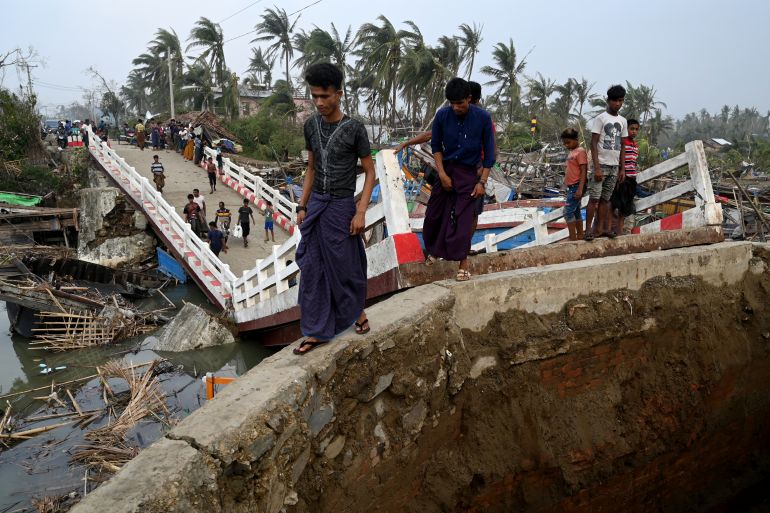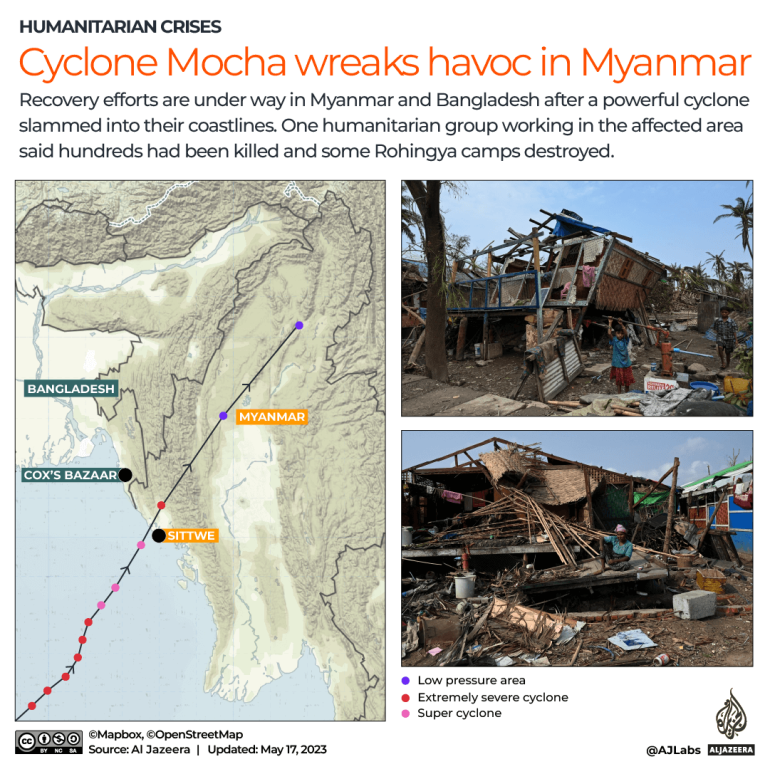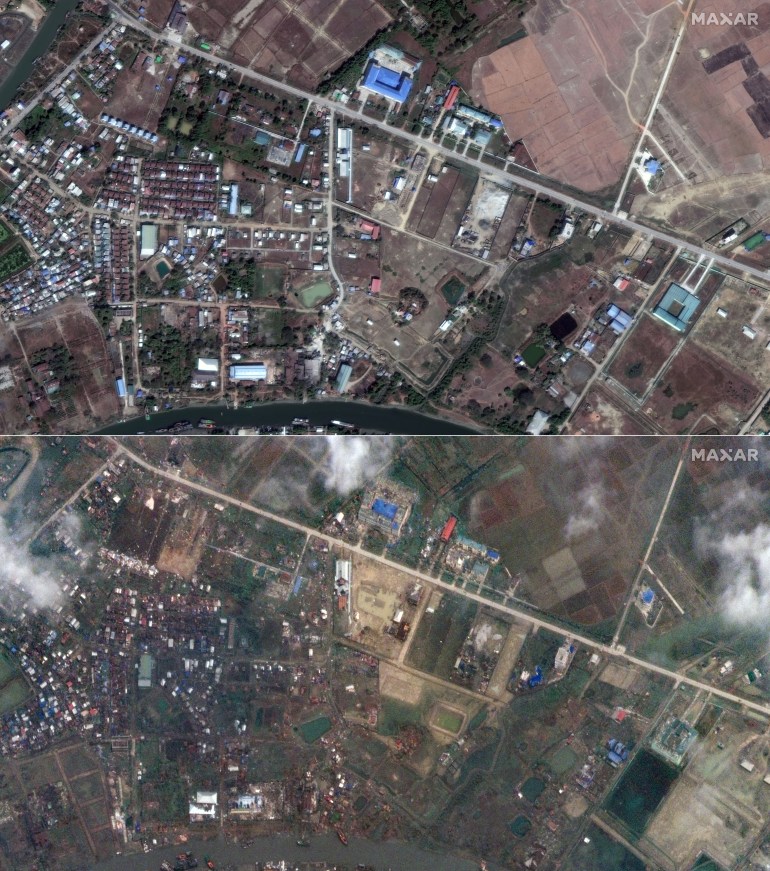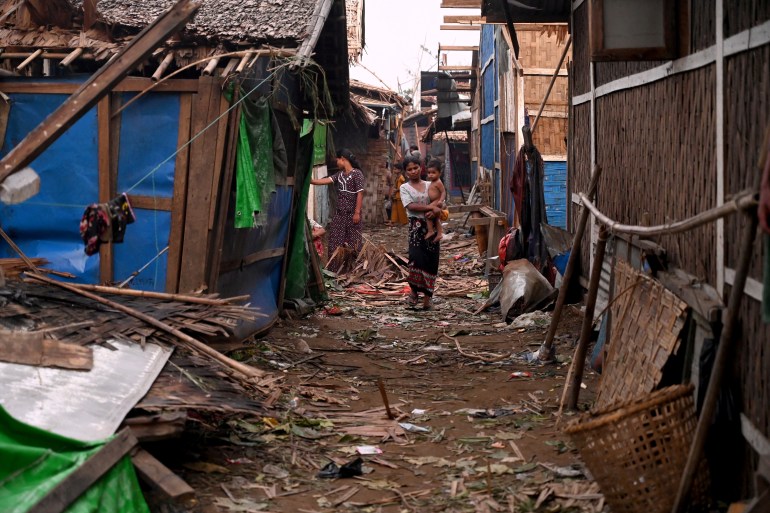Cyclone Mocha may have killed ‘hundreds’ in Myanmar’s Rakhine
Communications problems are making it difficult to assess the extent of the damage caused by the massive storm.

Rescue and relief efforts are under way in northwestern Myanmar and neighbouring Bangladesh after Cyclone Mocha crashed ashore, with one humanitarian group working in the affected area saying hundreds had been killed and some Rohingya camps destroyed.
The cyclone – one of the most powerful to ever hit the region – made landfall on Sunday between Sittwe in Myanmar’s Rakhine state and Cox’s Bazar in Bangladesh, where some one million mostly Muslim Rohingya fled after a brutal 2017 crackdown.
Keep reading
list of 3 itemsThousands evacuated as Cyclone Mocha nears Myanmar, Bangladesh
Photos: Cyclone Mocha batters Myanmar, Bangladesh
On Monday night, Myanmar’s military regime declared conflict-hit Rakhine, which it does not fully control, a “disaster area”, after winds as strong as 250 kilometres per hour (155 miles per hour) brought down trees and telecommunication towers and ripped roofs from buildings.

Torrential rain and a storm surge of between 3 and 3.5 metres (10-11.5 feet) also caused widespread flooding in the low-lying area, with the United Nations Office for the Coordination of Humanitarian Affairs (UNOCHA) saying there had been widespread destruction in and around Sittwe.
“Early reports suggest that damage is extensive and needs among already vulnerable communities, particularly displaced people, will be high,” it said in an update on Monday, noting that communications with the area were difficult.

More than two million people were living in the path of Cyclone Mocha, including hundreds and thousands of Rohingya who remained in Rakhine following the 2017 crackdown where they were living in squalid camps with severe restrictions on their movement.
Partners Relief and Development, which works in Rakhine, said Rohingya contacts living near Sittwe told them their camps had been almost destroyed and that other early reports were “counting the death toll in the hundreds”.
Aung Kyaw Moe, a Rohingya activist and adviser to the National Unity Government’s Ministry of Human Rights, said on Twitter that the number of deaths in Sittwe alone was 400. He shared video of flattened buildings, but did not elaborate.
The military-owned Myawaddy Channel reported on Monday that three people had been killed in the cyclone.
Sharif Ahmad, head of programmes for Myanmar and Bangladesh at Islamic Relief Worldwide, told Al Jazeera that displaced people in the region are especially vulnerable to extreme weather events.
“Rakhine state is a conflict area and the people’s socio-economic condition is very poor, so the housing conditions and other facilities are not so strong,” he said from Bangladesh’s capital, Dhaka.
Ahmad described the destruction in camps housing internally displaced people as well as in nearby rural communities as “massive”, with shelters badly damaged and water washing away people’s belongings.
“Right now, no one can reach there with a vehicle; there is only way to go there, with a motorcycle, because the roads are not fully cleared yet,” added Ahmad, noting that there is an urgent need to provide people with food and other basic items, as well as ensure the safety for women and children.

Myanmar was plunged into crisis after the military seized power from the elected government of Aung San Suu Kyi in February 2021, igniting mass protests that have turned into an armed rebellion.
People in Rakhine have suffered years of conflict and displacement, with the military and the United League of Arakan (ULA), the political wing of the ethnic Arakan Army, each claiming administrative control in the state.
The state-run Global New Light of Myanmar carried a report in its Monday edition showing army chief Senior General Min Aung Hlaing at an emergency meeting of the natural disaster committee.
The coup leader said it was “necessary to give a helping hand to all Myanmar citizens without leaving anyone”. Myanmar does not consider the Rohingya citizens.
State media reported on Tuesday the general had visited Sittwe, but made no mention of casualties, according to the Reuters news agency.
Hundreds of thousands of people in Myanmar and Bangladesh were evacuated to shelters before the cyclone.
While the camps in Bangladesh appear to have escaped the worst of the cyclone, there were reports on Tuesday of a fire in one of the densely-populated settlements.